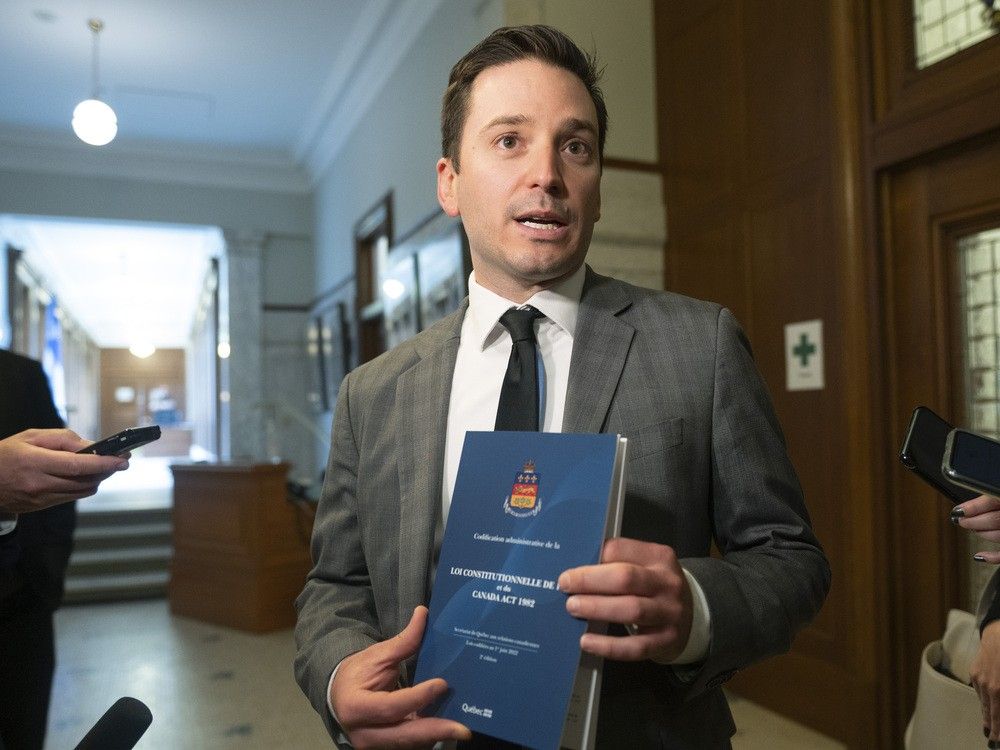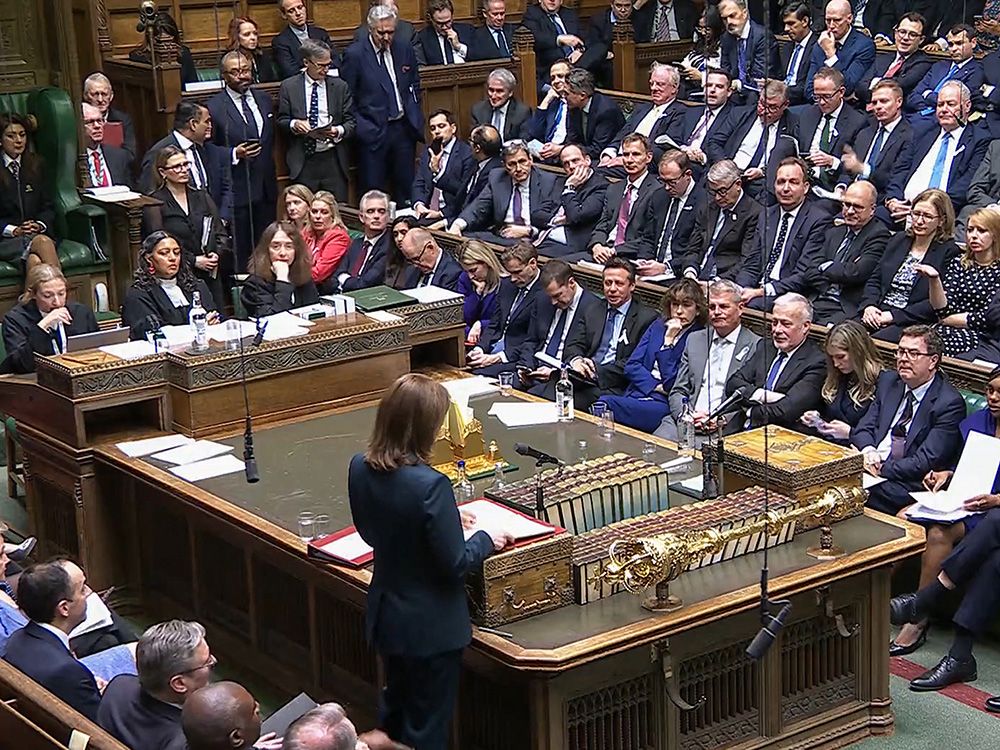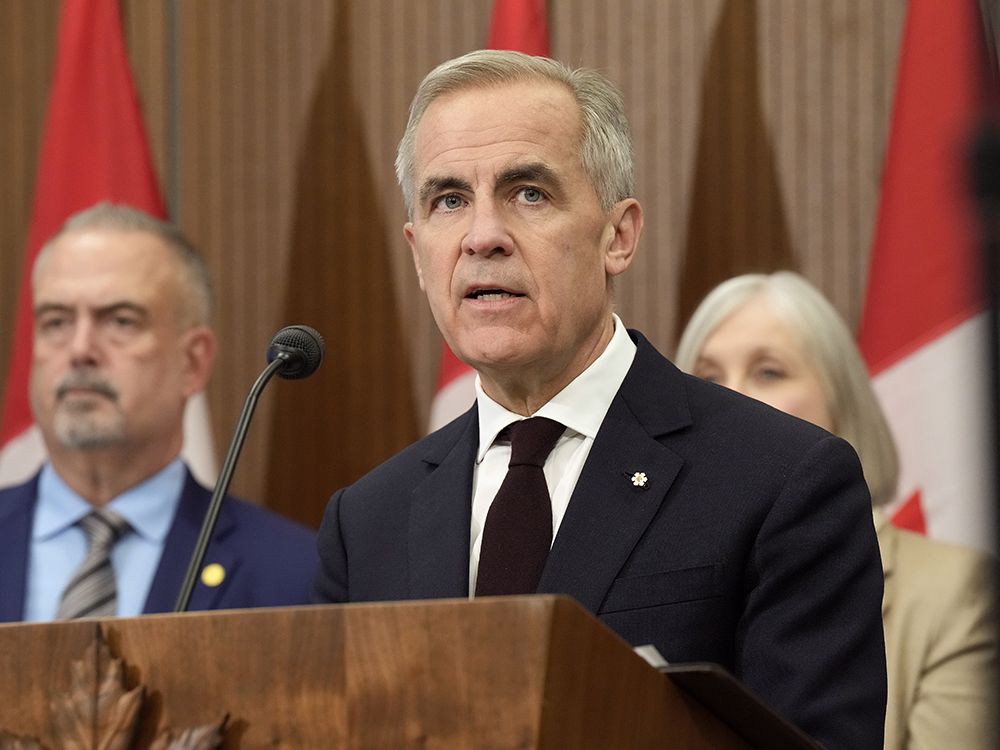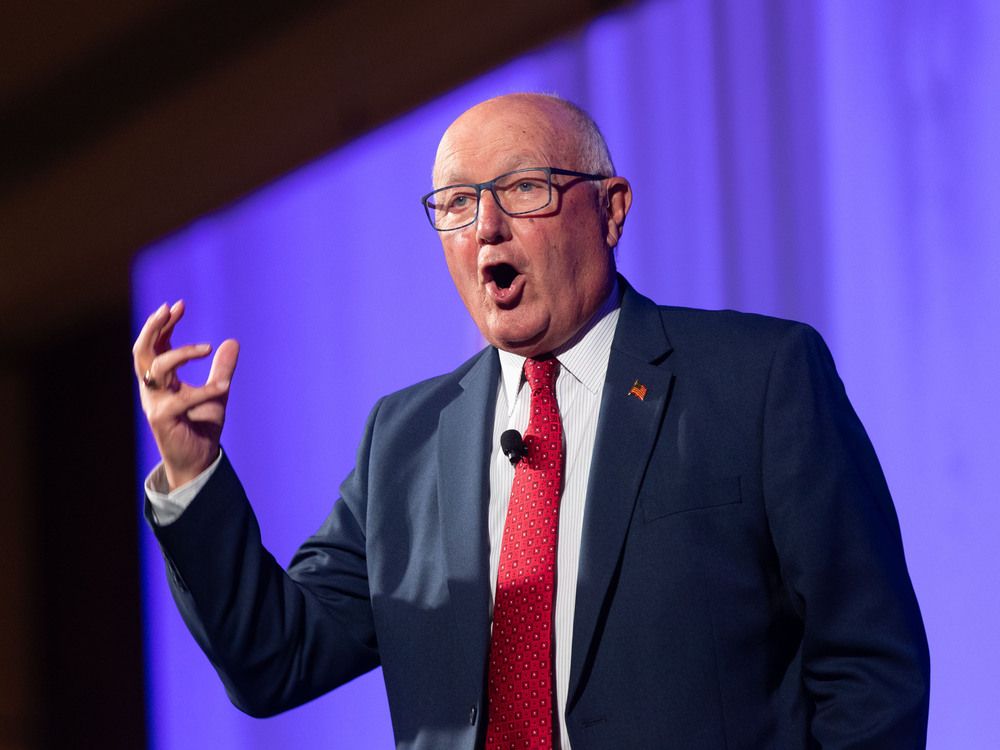
WASHINGTON, D.C. — Canada has
fared pretty well
amid U.S. President Donald Trump’s trade war so far. As Prime Minister Mark Carney likes to point out, the country has the best trade deal going with the United States, thanks to the Canada-U.S.-Mexico Agreement (CUSMA), with over 85 per cent of exports to America being tariff-free. The trouble is, that could change in the year ahead as the 2026 joint review of CUSMA gets underway.
All three countries have launched consultation processes ahead of the renegotiation process to get stakeholders’ feedback on the trade agreement’s pros and cons. The next and crucial step in the U.S. involves in-person testimony at the U.S. Trade Representative (USTR) hearings in Washington, D.C., from December 3 to 5, where more than 170 witnesses are scheduled to share their views. The proceedings will help the USTR gather information to inform its report to Congress, which could shape Trump’s approach to next year’s renegotiation talks.
The Future Borders Coalition, a bi-national organization dedicated “to building a better Canada-U.S. border for travel and trade,” submitted testimonials to the CUSMA review process and noted that fewer than 10 focused on Canada-U.S. trade. Having noticed that “narrowly protectionist viewpoints appear to dominate the docket,” Laura Dawson, the coalition’s executive director, is eager to testify.
To gain a better understanding of the USTR hearings and the review process, National Post talked to Dawson, who previously served as the senior economic specialist at the U.S. Embassy in Canada and as a senior advisor on economic affairs for the U.S. Department of State, about her upcoming testimony.
This Q&A has been edited for length and clarity.
Q: What are the priorities that the Future Borders Coalition is urging the U.S., Canada, and Mexico to address in the upcoming CUSMA review?
A:
The coalition is really focused on practical things that the three countries can do together to advance the interests of business, reduce compliance costs, and reduce the regulatory burden. We are in that do-no-harm camp that sees CUSMA as an important document that forms the legal basis of an extremely pivotal commercial relationship between the three countries. We don’t want to screw that up. So first, do no harm. But there are some specifics that we should be taking on to make it better. Our membership draws a lot from the supply chain community — transportation, movement of people — so we are quite oriented toward those practical aspects, the nuts and bolts of getting things and people from one place to another.
Q: You’ve said that a protectionist slant dominates the USTR’s docket. How do you expect this to shape the testimony, and what’s at risk if the broader trilateral perspectives are sidelined?
A:
In my former life, as an employee of the U.S. State Department in Canada and an advisor in the embassy there, I worked with USTR on a number of things, including similar consultations. These consultations tend to attract people who have a grievance. If you’re happy with the way things are, you’re not going to take the time to participate in this process, which is fairly bureaucratic and onerous. It’s also going to attract folks who have resources to pay professional lobbyists and some lawyers to craft their presentations. What gets missed are the people who are generally benefiting from the agreement, and/or small and medium-sized businesses that don’t have the resources to participate.
We do see some positive elements, for example, in the submissions from the National Association of Manufacturers, U.S. Chamber of Commerce and the Business Roundtable. They give some great statistics about the macro level of the relationship and investment and jobs, etc. But as an official who’s receiving these submissions, you’re going, “Okay, so now what? What’s the action plan for the next thing that we have to do?” You really want to be very specific.
From our perspective, the Future Borders Coalition, we’re interested in customs facilitation and nuts-and-bolts trade issues, as in, “Here are five things that we would like to see.”
We are concerned that we’re not taking cross-border energy flow seriously enough, so we are drilling down on that. We’re concerned that we are not utilizing digital tools effectively to both enhance trade and enhance security. There are thousands of things that we could be grabbing from, but in talking to our members and in looking at the gaps that are not well represented, that’s where we decided to go.
There are so few groups that are oriented to Canada-U.S. trade, so we really feel like it’s a voice that needs to be heard at this submission because so much of it is going to be about U.S.-Mexico trade.
Q: Having been on the other side of this process, are you concerned by the fact that it tends to focus more on grievances, or does it get balanced later?
A:
I’d like to say it comes out in the wash because I take a sort of policy wonk, economist view of things, and I think, well, surely they’ll look at the volume of trade flow and recognize how important this Canada-U.S. trade is to the overall welfare of Americans.
But in these situations, the economic argument, the business case, is not enough because you have the political case as well. You have a lot of legislators who are mobilized in one direction or another. You’ve got politicians pushing some issues higher and moving some issues down.
So you have to make your business case, but you’ve got to hope that your presentation aligns with some of the politically connected participants as well. So, for example, in the last CUSMA review, the American Farm Bureau was incredibly important for Canada-U.S. trade because the American Farm Bureau was really interested in making sure it preserved export markets for American farmers. So they got the attention of the agriculture sector, which got the attention of Donald Trump, who put that issue on the front burner. So the business case is never enough. You have to be aligned with those who have more political weight.
Q: How does FBC’s submission differ from the protectionist or country-specific narratives dominating the docket?
A:
Number one, we are providing some very specific recommendations, saying “here are some of the nuts-and-bolts issues that you can do tomorrow on inefficiencies in the way that oil moves across the border, the ways we track rules of origin for energy, inefficiencies in various customs regulatory issues.” You have to have that big picture to capture their attention. But then you have to be very specific: Here are the six things — six action items — that we think you should focus on. It can’t just be, “Hooray, we build things together.”
Q: What specific customs modernization and digital innovation proposals are you advocating to enhance border administration and trade facilitation?
A:
We want to make sure that we maintain a free flow of data between the two countries and more globally, while at the same time ensuring that privacy rights are upheld and that we don’t regulate digital data, movement of data, on the basis of geography, but rather on the basis of an ability to take care of it responsibly. On customs modernization, there are issues with truck repositioning and shipping. The other issue is the Section 301s (imposing new port service tariffs) against Chinese-made ships that operate on the North American coast and in the Great Lakes and the St. Lawrence. That is an issue that continues to rear its head for us. We thought that there was a resolution on that in the Xi-Trump deal, but it’s not clear. So we’re going to continue to advocate that cooler heads prevail … We respect the intention to build U.S. and North American shipbuilding at home, but let’s engage in this process over a phased or staged period of time because an immediate prohibition doesn’t solve anything. It still would take 10-12 years to get North American or American-made ships into the supply chain. So don’t penalize what we have now in order to achieve this long-term goal.
Interestingly, when it comes to “do no harm,” that’s something that is explicitly written into the USTR request for comments, which I found very interesting. This indicates to me that there are people thinking about these issues who don’t want to dismantle the agreement, who do see that this agreement has strong structure and bones and needs to be augmented and improved, but not necessarily torpedoed.
Q: With energy policy emerging as a key bilateral issue, what concrete steps is your organization recommending for advancing cross-border energy cooperation and renewable investment?
A:
We’re focusing on specifics related to things like diluent in pipelines and rules of origin affecting diluent, which I know would just make your eyeballs dry up. But it’s actually quite important. We never had to deal with disputes in the cross-border oil sector before, because the customer always wanted the oil, so they weren’t going to put a tariff on it. Now that we have this attention on cross-border movement of energy, there are opportunities to focus on the specific irritants. This is wrapped in a package — improvements in infrastructure and investment. But you have to know your audience, and I’m dealing with USTR, which is charged with the maintenance and improvement of trade law. I’m not going too far down in the weeds of the bigger picture infrastructure investment, working together. I want to be sure that I am pitching the balls that USTR can hit. At the same time, our organization is very interested in how we can build better, stronger relationships in areas that Canada and the U.S. both agree are important, so critical minerals, transportation, border security, energy, food, and agriculture. These are areas where we have strong embeddedness integration and where it makes no sense to abandon what we’ve got already.
Q: How should the CUSMA review address digital trade and AI governance risks while fostering North American digital integration?
A:
The U.S. actually had a fair amount of leadership on global digital trade during the era of the Trans-Pacific Partnership, when the U.S. was still involved in that. They have had less focus in recent years on how to build a strong, globalized digital ecosystem and how to regulate that. The absence of their leadership has really been felt in these sort of piecemeal activities. There’s just been a real lack of momentum on digital regulation that rewards innovation but also protects individual rights and privacy. So when we’re speaking to Canada about these issues, we’re focusing on things like the Online Streaming Act, the Digital Services Tax, etc, encouraging Canada to find ways to advance public interest without hurting the ecosystem for innovation in Canada.
On the U.S. side, we’re encouraging leadership and really embedding/expanding coverage in the CUSMA since the original 1994 NAFTA did not foresee the enormous growth of the cross-border digital economy.
Q: Do you expect Canada’s digital legislation to become a sticking point in the CUSMA review?
A:
Yes, I would expect that the Online Streaming Act would be something that comes back to Canada. It’s not difficult to predict what’s going to be on the U.S. side of the table vis-a-vis Canada. If you look at the USTR National Trade Estimates, which they publish every year, it’s kind of their irritants list per country. You’ll see the list for Canada, and about 50 per cent of that is agriculture, dairy. The other 50 per cent is on ownership in telecoms and banking and also the Online Streaming Act, and other concerns about digital. So, we will go through these processes and spin the wheel in hopes that we get attention to issues that need attention and we can improve on. But, ultimately, the final result for Canada is going to look a lot like what we see in the National Trade Estimates.
Canada should expect pressure, but for CUSMA, the vast majority of irritant challenges and problems are on the Mexico side. Canada is struggling to get attention at that review. So you want to have negotiators who are well-prepared, have good, strong statements of “here’s the five things that we want to do that are going to help us and are going to help you at the same time.”
Q: Why is Mexico so much more of the focus?
A:
Because Mexico’s economy is at a different level of development, with continuing issues related to compliance with labour standards, rules of origin, and energy ownership. At the same time, Mexico attracts a lot of attention in the United States because it has a bigger stick, negatively, that it can wield. Canada is a good lawful partner on its northern border, but Mexico has a lot of challenges related to movement of people, illicit trade, cartel activity, and the U.S. really requires Mexico to be a very focused partner to help eradicate or mitigate these issues. If Mexico says, “forget about it, we’re not inclined to be a partner on these issues,” then the U.S. gets very nervous.
Q: What are the biggest challenges traders face today that your organization believes could be alleviated by greater adaptation of digital rules or tools, such as AI-based compliance or blockchain, when it comes to customs or border operations?
A:
Our customs CVSA (Commercial Vehicle Safety Alliance) has been attempting a modernization initiative and should be applauded for that, but they don’t have nearly the tools for analysis, for scanning, for screening, for having intelligence in advance of a cargo coming to the border that they need to be able to say, “yes, this is a low-risk shipment and a low-risk shipper, let’s send them on their way” versus “no, this is high risk, let’s give them more attention.” So our organization’s been working on a lot of different fronts, federal, provincial, local, to try to improve the suite of tools available for people making supply chain admissibility decisions – and ensuring that these tools are interoperable between the United States, Canada, and Mexico. It makes no sense to have different tools available. Things like blockchain, advanced scanning, non-intrusive imaging, AI network analysis mean you can just identify whether the shipper is one with a good history or has some sketchy things in the background. You want to know that before the cargo gets there. So that’s something we’re really leaning into, and a few words of endorsement, specific undertakings in the CUSMA could open up the opportunity to engage in those kinds of MOUs and initiatives and pilot projects and new developments that we’d like to see at the practical realm.
Q: Given CUSMA’s importance for millions of jobs and economic stability in both countries, what are the risks if the review deviates toward becoming an ongoing renegotiation, as we’ve seen this year, or even disruption? How critical is its continuity?
A:
Continuity is very critical. There are people who are taking an apocalyptic view, like “it’s going to be all over, we won’t have that deal.” The reality is, it would be a slow deterioration. Written into the CUSMA review process, there’s a period of years during which there’s an opportunity to go back to the table, back to the table, back to the table. But you would be diminishing investor confidence and making Canada and North America look like a lot less attractive place to invest. Meanwhile, manufacturers will be diversifying to other markets because North America is not as reliable and attractive as it has been in the past.
I think that affects Canada more than it affects the United States because the United States still continues to be a very vibrant economic market. Whatever you think about, what’s going on, Canada is attractive because it has access to the larger North American market. It has preferential access that no other country except Mexico has to the United States. If it loses that preferential access, it’s going to mean an economic hit for Canada, and it will make it a lot harder for Canadian businesses to work elsewhere in the world.
Q: What are your greatest hopes and fears for the year ahead with the renegotiation?
A:
With this agreement, we have an opportunity to do a lot of good things. My organization focuses on the details. We focus on things that can improve competitiveness, employment, and jobs. So my hope is that we can really get to the nuts and bolts that will allow us to strengthen, deepen, and make more transparent the North American integrated economy.
My fear is that the process becomes so politicized and a political debate, rather than an opportunity to achieve the economic aims.
Q: What’s happening with Canada’s consultation process?
A:
A lot of the dynamics right now are domestic in Canada. They’re not so much about a cross-border dispute or cross-border communications. Canada has a great opportunity to address a lot of domestic competitiveness issues and establish itself as a more nimble, export-oriented economy.
What I’m hearing from businesses, my members and others, is that they’re not feeling like they’re part of the process right now. They’re not being consulted in the preparation for this agreement, as they were in the past. It seems like a black box to them. And in the past, business and technical advice has been really, really important so that if you’re in a room talking about energy, for example, you want the energy sector to be next door saying “this, but not that this, makes sense.”
Canada did just reopen its own consultation, and that’s great, but I’m hearing from businesses over and over that they’re not being consulted in Canada.
National Post
Our website is the place for the latest breaking news, exclusive scoops, longreads and provocative commentary. Please bookmark nationalpost.com and sign up for our newsletters here.





















